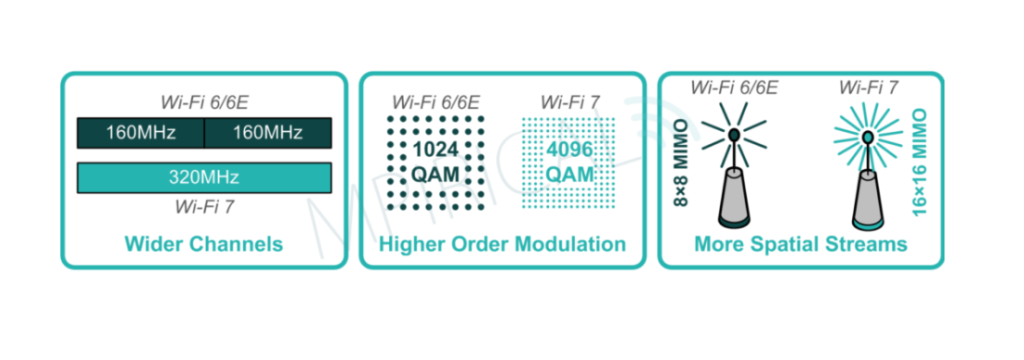In today’s fast-paced world of technology, our reliance on WiFi has grown more significant than ever before. Whether it’s streaming videos or working remotely, having a stable and high-speed internet connection is absolutely crucial. Over the years, WiFi technology has undergone significant evolution, offering not only faster speeds but also enhanced range and overall performance. In this comprehensive blog post, we will delve deep into the realm of WiFi, meticulously comparing the different generations – Wi-Fi 4, Wi-Fi 5, Wi-Fi 6, Wi-Fi 6E, and the highly anticipated WiFi 7. So, let’s embark on a journey to explore the captivating evolution of WiFi and gain insights into how each generation distinguishes itself from the others.

WiFi 4: 802.11n – A Glimpse into the Past
Notably, WiFi 4, also recognized as 802.11n, marked a significant turning point when it was introduced in 2009. Furthermore, it predominantly operated in the 2.4GHz band, delivering an impressive maximum speed of 600Mbps. Additionally, boasting a range of 70 meters indoors and an extended reach of 250 meters outdoors, Wi-Fi 4 presented a substantial upgrade compared to its predecessors.
Key Features:
- Band: 2.4GHz
- Protocol: 802.11n
- Max Speed: 600Mbps
- Range: 70m indoor, 250m outdoor
- MIMO: 4 × 4
WiFi 5: 802.11ac – The Transition to High Speeds
In 2013, WiFi 5, also referred to as 802.11ac, made its debut, operating exclusively in the 5GHz band. Remarkably, it boasted impressive speeds, reaching up to 6.9Gbps. Moreover, it offered a range of 35 meters indoors, a range that expanded to an impressive 80 meters when equipped with three antennas. Undoubtedly, this generation marked a significant leap in Wi-Fi performance.
Key Features:
- Band: 5GHz
- Protocol: 802.11ac
- Max Speed: 6.9Gbps
- Range: 35m indoors (80 meters with 3 antennas)
- MIMO: 8 × 8
WiFi 6: 802.11ax – Redefining Connectivity
Overview: WiFi 6, based on the 802.11ax protocol, was introduced in 2019. It operated in both the 2.4GHz and 5GHz bands, providing a maximum speed of 9.6Gbps. With an improved range and the capability to connect multiple devices simultaneously, WiFi 6 addressed the growing demands of modern connectivity.
Key Features:
- Bands: 2.4GHz and 5GHz
- Protocol: 802.11ax
- Max Speed: 9.6Gbps
- Range: 30m indoor, 120m outdoor
- MIMO: 8 × 8
WiFi 6E: 802.11ax in the 6GHz Band
Overview: WiFi 6E, an extension of WiFi 6, was introduced in 2020. It operated exclusively in the 6GHz band and offered the same impressive 9.6Gbps speed. While it didn’t provide a significant boost in range, it opened up new channels for less interference and improved performance in crowded environments.
Key Features:
- Band: 6GHz
- Protocol: 802.11ax
- Max Speed: 9.6Gbps
- Range: Varies
- MIMO: 8 × 8
WiFi 7: The Future of Wireless Connectivity
Overview: While Wi-Fi 7 is still in the testing phase and expected in 2024, it promises to be a game-changer. Operating in the 2.4GHz, 5GHz, and 6GHz bands, Wi-Fi 7, based on the 802.11be protocol, aims to deliver blazing speeds of up to 46Gbps. With 16 × 16 MIMO, it has the potential to revolutionize how we connect to the internet.
Key Features (Expected):
- Bands: 2.4GHz, 5GHz, and 6GHz
- Protocol: 802.11be
- Max Speed (Expected): 46Gbps
- Range: Similar to Wi-Fi 6
- MIMO: 16 × 16

Choosing the Right Wi-Fi Generation for You
Now that we’ve explored the evolution of Wi-Fi, how do you choose the right generation for your needs? Here are some considerations:
Speed Requirements
If you need blazing-fast speeds for activities like 4K streaming and online gaming, Wi-Fi 6 or Wi-Fi 7 (when available) is your best bet.
Understanding WiFi Range
For larger homes or outdoor coverage, Wi-Fi 4 and Wi-Fi 5 offer better range. However, if you have a smaller living space, Wi-Fi 6 or 6E should suffice.
Ensuring Device Compatibility with Wi-Fi Technology
Consider the devices you own. Newer devices are likely to support the latest Wi-Fi standards, so compatibility is essential.
Crowded Environments
If you live in a densely populated area with many Wi-Fi networks, Wi-Fi 6 and 6E’s improved interference handling may be beneficial.
Future-Proofing Your WiFi Wireless Network
Investing in the latest Wi-Fi technology ensures your network stays relevant for years to come.
Conclusion: The Future of Connectivity
The evolution of WiFi has been nothing short of remarkable. From the early days of WiFi 4 to the upcoming WiFi 7, each generation has brought significant improvements in speed, range, and performance. As technology continues to advance, our need for faster and more reliable internet connections will persist. Whether you’re streaming, gaming, working, or simply browsing, the Wi-Fi generation you choose can make a world of difference in your online experience. Stay tuned for the arrival of WiFi 7, set to redefine wireless connectivity once again.
Get the more details here: News Category
For more tech insights and updates, stay tuned to www.nois-tech.


